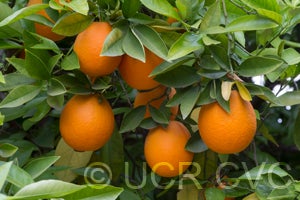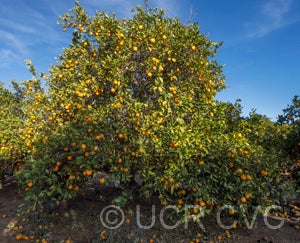Citrus sinensis (L.) Osbeck RUTACEAE
CRC 3251
PI 539608
Source
Received as budwood from Ted Frolich, UCLA, 1960.
Parentage/origins
Reported to be a sport of Shamouti orange. Originally from Egypt.
Rootstocks of accession
Carrizo citrange, C-35 citrange
Season of ripeness at Riverside
January to March
Notes and observations
EMN:From Egypt to UCLA. Bud from a seedling introduced by R.W. Hodgson- a sport of Shamouti orange. This orange is described in TCI, Vol. I, pp 453, as "Shamouti Masry (Khalily White, Egyptian Shamouti)". Trees & fruit look like Shamouti.
7/8/1988, EMN: Close examination of 10 fruit of each indicates that this and CRC 3746, Shamouti, are identical.
Description from The Citrus Industry Vol. 1 (1967)
"Fruit medium-large, ellipsoid to oval; seeds few or none. Color orange to deep orange. Rind medium-thick; surface finely pitted and relatively smooth; peels readily. Flesh well-colored; juicy; flavor rich and sweet. Midseason in maturity. Indistinguishable from Shamouti.
Tree moderately vigorous; leaves large; Shamouti-like in appearance; productive.
This variety is said to have originated in the orchard of Moustafa Khalili in Kalioubiyah Province, Egypt; whether it occurred as a seedling or limb sport is not reported. It is preferred to Shamouti because the tree is more productive and the fruit somewhat smaller and of finer texture. From descriptions it is evident that this variety and Maltaise Blonde or Petite Jaffa of North Africa are very much alike."
Availability
Not commercially available in California.
USDA Germplasm Resources Information Network page for Khalily sweet orange



